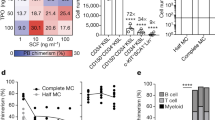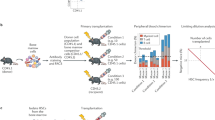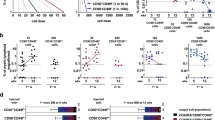Abstract
Utilizing multipotent and self-renewing capabilities, hematopoietic stem cells (HSCs) can maintain hematopoiesis throughout life. However, the mechanism behind such remarkable abilities remains undiscovered, at least in part because of the paucity of HSCs and the modest ex vivo expansion of HSCs in media that contain poorly defined albumin supplements such as bovine serum albumin. Here, we describe a simple platform for the expansion of functional mouse HSCs ex vivo for >1 month under fully defined albumin-free conditions. The culture system affords 236- to 899-fold expansion over the course of a month and is also amenable to clonal analysis of HSC heterogeneity. The large numbers of expanded HSCs enable HSC transplantation into nonconditioned recipients, which is otherwise not routinely feasible because of the large numbers of HSCs required. This protocol therefore provides a powerful approach with which to interrogate HSC self-renewal and lineage commitment and, more broadly, to study and characterize the hematopoietic and immune systems.
This is a preview of subscription content, access via your institution
Access options
Access Nature and 54 other Nature Portfolio journals
Get Nature+, our best-value online-access subscription
$29.99 / 30 days
cancel any time
Subscribe to this journal
Receive 12 print issues and online access
$259.00 per year
only $21.58 per issue
Buy this article
- Purchase on Springer Link
- Instant access to full article PDF
Prices may be subject to local taxes which are calculated during checkout







Similar content being viewed by others
Data availability
All raw data are available upon reasonable request.
References
Eaves, C. J. Hematopoietic stem cells: concepts, definitions, and the new reality. Blood 125, 2605–2613 (2015).
Seita, J. & Weissman, I. L. Hematopoietic stem cell: self-renewal versus differentiation. Wiley Interdiscip. Rev. Syst. Biol. Med 2, 640–653 (2010).
Orkin, S. H. & Zon, L. I. Hematopoiesis: an evolving paradigm for stem cell biology. Cell 132, 631–644 (2008).
Yamamoto, R., Wilkinson, A. C. & Nakauchi, H. Changing concepts in hematopoietic stem cells. Science 362, 895–896 (2018).
Osawa, M., Hanada, K., Hamada, H. & Nakauchi, H. Long-term lymphohematopoietic reconstitution by a single CD34-low/negative hematopoietic stem cell. Science 273, 242–245 (1996).
Copelan, E. A. Hematopoietic stem-cell transplantation. N. Engl. J. Med 354, 1813–1826 (2006).
Kumar, S. & Geiger, H. HSC niche biology and HSC expansion ex vivo. Trends Mol. Med 23, 799–819 (2017).
Wilkinson, A. C. et al. Long-term ex vivo haematopoietic-stem-cell expansion allows nonconditioned transplantation. Nature 571, 117–121 (2019).
Ieyasu, A. et al. An all-recombinant protein-based culture system specifically identifies hematopoietic stem cell maintenance factors. Stem Cell Rep. 8, 500–508 (2017).
Yamamoto, R. et al. Clonal analysis unveils self-renewing lineage-restricted progenitors generated directly from hematopoietic stem cells. Cell 154, 1112–1126 (2013).
Yamamoto, R. et al. Large-scale clonal analysis resolves aging of the mouse hematopoietic stem cell compartment. Cell Stem Cell 22, 600–607.e604 (2018).
Cabezas-Wallscheid, N. et al. Identification of regulatory networks in HSCs and their immediate progeny via integrated proteome, transcriptome, and DNA methylome analysis. Cell Stem Cell 15, 507–522 (2014).
Ramsfjell, V. et al. Thrombopoietin, but not erythropoietin, directly stimulates multilineage growth of primitive murine bone marrow progenitor cells in synergy with early acting cytokines: distinct interactions with the ligands for c-kit and FLT3. Blood 88, 4481–4492 (1996).
Seita, J. et al. Lnk negatively regulates self-renewal of hematopoietic stem cells by modifying thrombopoietin-mediated signal transduction. Proc. Natl Acad. Sci. USA 104, 2349–2354 (2007).
Kiel, M. J., Yilmaz, O. H., Iwashita, T., Terhorst, C. & Morrison, S. J. SLAM family receptors distinguish hematopoietic stem and progenitor cells and reveal endothelial niches for stem cells. Cell 121, 109–1121 (2005).
Morita, Y., Ema, H. & Nakauchi, H. Heterogeneity and hierarchy within the most primitive hematopoietic stem cell compartment. J. Exp. Med. 207, 1173–1182 (2010).
Ema, H. et al. Adult mouse hematopoietic stem cells: purification and single-cell assays. Nat. Protoc. 1, 2979–2987 (2006).
Challen, G. A., Boles, N., Lin, K. K. & Goodell, M. A. Mouse hematopoietic stem cell identification and analysis. Cytom. A 75, 14–24 (2009).
Lo Celso, C. & Scadden, D. Isolation and transplantation of hematopoietic stem cells (HSCs). J. Vis. Exp. (2):157 https://doi.org/10.3791/157 (2007).
Frascoli, M., Proietti, M. & Grassi, F. Phenotypic analysis and isolation of murine hematopoietic stem cells and lineage-committed progenitors. J. Vis. Exp. 2012, 3736 (2012).
Bhattacharya, D., Rossi, D. J., Bryder, D. & Weissman, I. L. Purified hematopoietic stem cell engraftment of rare niches corrects severe lymphoid deficiencies without host conditioning. J. Exp. Med. 203, 73–85 (2006).
Shimoto, M., Sugiyama, T. & Nagasawa, T. Numerous niches for hematopoietic stem cells remain empty during homeostasis. Blood 129, 2124–2131 (2017).
Purton, L. E. & Scadden, D. T. Limiting factors in murine hematopoietic stem cell assays. Cell Stem Cell 1, 263–270 (2007).
Wilson, N. K. et al. Combined single-cell functional and gene expression analysis resolves heterogeneity within stem cell populations. Cell Stem Cell 16, 712–724 (2015).
Luchsinger, L. L. et al. Harnessing hematopoietic stem cell low intracellular calcium improves their maintenance in vitro. Cell Stem Cell 25, 225–240.e7 (2019).
Slukvin, I. I. Hematopoietic specification from human pluripotent stem cells: current advances and challenges toward de novo generation of hematopoietic stem cells. Blood 122, 4035–4046 (2013).
Slukvin, I. I. & Uenishi, G. I. Arterial identity of hemogenic endothelium: a key to unlock definitive hematopoietic commitment in human pluripotent stem cell cultures. Exp. Hematol. 71, 3–12 (2019).
Wilkinson, A. C. et al. Expanded potential stem cell media as a tool to study human developmental hematopoiesis in vitro. Exp. Hematol. 76, 1-12.e5 (2019)
Fares, I. et al. Cord blood expansion. Pyrimidoindole derivatives are agonists of human hematopoietic stem cell self-renewal. Science 345, 1509–1512 (2014).
Boitano, A. E. et al. Aryl hydrocarbon receptor antagonists promote the expansion of human hematopoietic stem cells. Science 329, 1345–1348 (2010).
Csaszar, E. et al. Rapid expansion of human hematopoietic stem cells by automated control of inhibitory feedback signaling. Cell Stem Cell 10, 218–229 (2012).
Dever, D. P. et al. CRISPR/Cas9 β-globin gene targeting in human haematopoietic stem cells. Nature 539, 384–389 (2016).
Bak, R. O., Dever, D. P. & Porteus, M. H. CRISPR/Cas9 genome editing in human hematopoietic stem cells. Nat. Protoc. 13, 358–376 (2018).
Acknowledgements
We thank the IMSUT FACS Core Laboratory for FACS support and M. Odai for filming. This research was funded by a JSPS KAKENHI Grant-in-Aid for Scientific Research (JP18H05095; JP17H05086), the Japan Agency for Medical Research and Development (JP18bm0404025), CIRM (LA1_C12-06917; DISC1-10555), the NIH (R01DK116944; R01HL147124; R21AG061487) and the Ludwig Foundation. A.C.W. was funded by Bloodwise (15050), the Leukemia and Lymphoma Society (3385-19), and the JSPS.
Author information
Authors and Affiliations
Contributions
A.C.W. designed and validated the protocol, and wrote and edited the manuscript. R.I. designed and validated the protocol, and edited the manuscript. H.N. supervised the research and edited the manuscript. S.Y. designed and validated the protocol, supervised the research, and edited the manuscript.
Corresponding authors
Ethics declarations
Competing interests
H.N. is a co-founder and shareholder of ReproCELL. Inc.
Additional information
Peer review information Nature Protocols thanks Nina Cabezas-Wallscheid, James Che and David Kent for their contribution to the peer review of this work.
Publisher’s note Springer Nature remains neutral with regard to jurisdictional claims in published maps and institutional affiliations.
Related link
Key reference using this protocol
Wilkinson, A. C. et al. Nature 571, 117–121 (2019): https://doi.org/10.1038/s41586-019-1244-x
Rights and permissions
About this article
Cite this article
Wilkinson, A.C., Ishida, R., Nakauchi, H. et al. Long-term ex vivo expansion of mouse hematopoietic stem cells. Nat Protoc 15, 628–648 (2020). https://doi.org/10.1038/s41596-019-0263-2
Received:
Accepted:
Published:
Issue Date:
DOI: https://doi.org/10.1038/s41596-019-0263-2
This article is cited by
-
Generating human bone marrow organoids for disease modeling and drug discovery
Nature Protocols (2024)
-
Cyclophilin A supports translation of intrinsically disordered proteins and affects haematopoietic stem cell ageing
Nature Cell Biology (2024)
-
Chemically defined cytokine-free expansion of human haematopoietic stem cells
Nature (2023)
-
Aged hematopoietic stem cells entrap regulatory T cells to create a prosurvival microenvironment
Cellular & Molecular Immunology (2023)
-
Loss of Nudt15 thiopurine detoxification increases direct DNA damage in hematopoietic stem cells
Scientific Reports (2023)
Comments
By submitting a comment you agree to abide by our Terms and Community Guidelines. If you find something abusive or that does not comply with our terms or guidelines please flag it as inappropriate.



